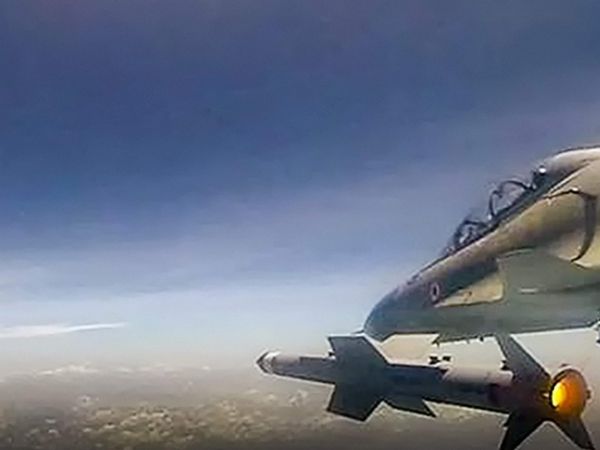Astra BVR Air To Air Missile Inducted By IAF

Dated : 16 Jan 2021 (IST)
The Astra is India’s first indigenous air-to-air missile. It is an all weather beyond visual range air to air missile developed by the DRDO. It features mid-course inertial guidance with terminal active radar homing.
It is designed to be capable of engaging targets at varying range and altitudes allowing for engagement of both short-range targets at a distance of 10 km and long-range targets up to a distance of 110 km.
Astra has already been integrated with SU30 MKI and will soon be integrated with Mirage 2000, MiG 29 of both IAF and Navy and Tejas too.
The missile is 3.6 m long and weighs 154 kg. It is capable of receiving course corrections through a secure data link. The missile’s active radar seeker has a homing range of 25 km. The seeker can lock-on to a target with a radar cross section of 5 square metres from a distance of 15 km.
Astra is equipped with ECM to allow operation even during enemy attempts to jam the seeker. It carries a 15 kg high explosive pre-fragmented warhead activated by a proximity fuze.
Astra uses a smokeless solid fuelled motor that can propel the missile to a speed of Mach 4.5 and allows operation from a maximum altitude of 20 km.
The maximum range of Astra is 110 km in head-on chase mode and 20 km in tail chase mode. The maximum range is achieved when the missile launched from an altitude of 3 km.
When it is fired from an altitude of 2 km, the range drops to 44 km and when it is launched from sea level, the range drops further to 21 km.
Astra can engage maneuvering targets up to a range of 90 km in head-on chase mode and 60 km in tail chase mode It can be launched in both autonomous and buddy mode operation and can lock on to its target before or after it is launched.
Preliminary work on Astra had begun by 1990 and was revealed to the public for the first time at Aero India 1998. The project to develop Astra missile was officially sanctioned in 2004 with a budget of ₹955 crore. It was tested for the first time in May 2003.
The missile was redesigned around 2006 due to control issues and performance deficiencies at high altitude. The redesigned missile had an improved propulsion system and was tested for the first time in 2008. By 2013, the missile had been redesigned again in response to multiple failures caused by adverse interactions between flight control surfaces.
The control, guidance, and propulsion systems were also reconfigured. After the second redesign, the missile was lighter than the initial version by around 130 kg. It was tested from a Sukhoi Su-30MKI in April 2013.
Astra completed final development trials in September 2017 and was cleared for production at Bharat Dynamics Limited’s manufacturing facility in Bhanur, for an initial order of 50 missiles. Additional Orders for 280 + missiles have already been placed.
Now the Indian Air Force on January 13 announced the induction of the indigenous, BVR air-to-air-missile, Astra.
While detailing its show of strength in the forthcoming Republic Day Parade, the IAF declared that the Astra has been integrated with Sukhoi-30MKI and will be integrated with the Mirage-2000, Tejas and MiG-29 (fleets) in the future.
Earlier against the Pakistan Air Force imported AIM-120 AMRAAMs with a range of 110 km, the maximum air-to-air reach of the IAF was under 80 km with the R-77. As a result, IAF’s frontline Su-30 MKIs were always forced to stay out of its reach or ensure defensive measures as done during PAF air strike post surgical strike on terrorist camp at Balakot in Pakistan on February 26.
The 110-km range of the Astra neutralises Pakistan’s advantage over India in air-to-air weaponry.
After the development of Astra Mark 1, three new variants are planned for future. Astra IR close combat missile for shorter range up to 80 km. Astra Mark 2 with larger engagement envelope and a range of 160 km. Astra Mark 3 will use newly developed ramjet technology with a maximum range of 350 km.
The flight trials on the indegenously built HAL Tejas are expected to begin in the first half ot 2021.




